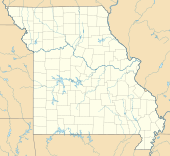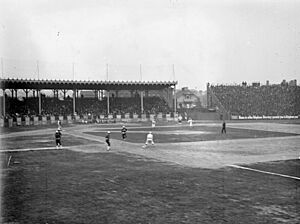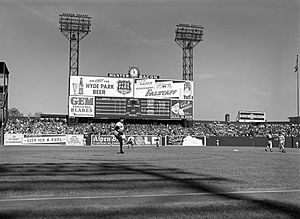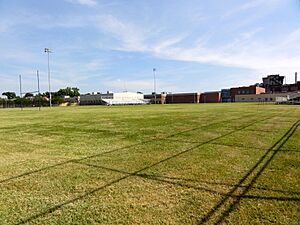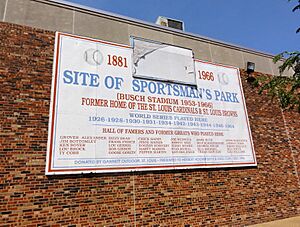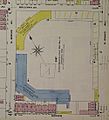Sportsman's Park facts for kids
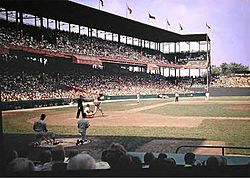
c. 1961
|
|
| Former names |
|
|---|---|
| Location | Sullivan Ave. 3623 Dodier St. (Cardinals) & 2911 N Grand Blvd (Browns). St Louis, Missouri, U.S. |
| Coordinates | 38°39′29″N 90°13′12″W / 38.658°N 90.220°W |
| Owner | St. Louis Cardinals (1953–1966) St. Louis Browns (1902–1953) |
| Operator | St. Louis Cardinals (1953–1966) St. Louis Browns (1902–1953) |
| Capacity |
|
| Field size | Left Field: 351 ft (107 m) Left-Center: 379 ft (116 m) Deepest corner (just left of dead center): 426 ft (130 m) Deepest corner (just right of dead center): 422 ft (129 m) Right-Center: 354 ft (108 m) Right Field: 310 ft (94 m) Backstop: 68 ft (21 m) |
| Surface | Natural grass |
| Construction | |
| Broke ground | 1880 |
| Opened | April 23, 1902 |
| Renovated | 1909 |
| Expanded | 1909 1922 1926 |
| Closed | May 8, 1966 |
| Demolished | 1966 |
| Construction cost | US$300,000 ($10.1 million in 2022 dollars ) $500,000 (1925 refurbishment) |
| Architect | Osborn Engineering Company |
| Tenants | |
|
|
Sportsman's Park was a famous baseball stadium in St. Louis, Missouri. It was home to two Major League Baseball teams. These were the St. Louis Browns and the St. Louis Cardinals. Most versions of the park stood on the same spot for many years.
Contents
A Look Back at Sportsman's Park History
Baseball games were played at the Sportsman's Park location as early as 1867. The first main building, called a grandstand, was built in 1881. At first, the field was known as the Grand Avenue Ball Grounds. It later became known as Sportsman's Park.
The St. Louis Brown Stockings, also called the "Browns," played here. They were a very strong team in the 1880s. Later, the team moved to a new park and changed their colors to red. This is how they became the St. Louis Cardinals.
The 1902 and 1909 Stadiums
In 1902, a new team, the St. Louis Browns, built a new Sportsman's Park. They placed the baseball diamond in a different spot on the land.
This stadium also made football history! It was the practice and home field for Saint Louis University football teams. Their coach, Eddie Cochems, was a pioneer of the forward pass in football. In 1906, a player named Bradbury Robinson threw an amazing long pass. Some reports say it traveled 87 yards in the air! This was incredible for the time, especially with the rugby-style ball they used.
In 1909, the Browns moved the diamond again to its final spot. They built a new, strong grandstand made of steel and concrete. This was one of the first stadiums of its kind. The Cardinals returned to Sportsman's Park in 1920, sharing it with the Browns.
World Series and Team Rivalry
In 1922, the Browns' owner, Phil Ball, thought his team would play in the World Series soon. He made the stadium bigger, increasing its seating from 18,000 to 30,000.
A World Series did happen at Sportsman's Park in 1926. But it was the Cardinals, not the Browns, who played in it! The Cardinals surprised everyone by beating the New York Yankees. This win made the Cardinals the favorite team in St. Louis.
The two teams, the Cardinals and the Browns, even played each other in the 1944 World Series. The Cardinals won that series too. This was the last World Series where both teams played in the same stadium.
Sportsman's Park also hosted other sports, like soccer. It held games for the St. Louis Soccer League. In 1948, it hosted the national soccer championship.
Becoming Busch Stadium
By the early 1950s, St. Louis couldn't really support two baseball teams. The Browns' owner, Bill Veeck, tried to make his team more popular. But the Cardinals were bought by Anheuser-Busch, a big company. This gave the Cardinals many more resources.
Veeck realized he couldn't compete. He sold Sportsman's Park to the Cardinals for $800,000. The stadium needed repairs, and the Cardinals' new owners quickly fixed it up. The Browns then moved to Baltimore and became the Orioles.
Anheuser-Busch wanted to name the stadium "Budweiser Stadium." But the baseball commissioner said no, because Budweiser is a beer brand. So, the park was renamed Busch Stadium after the company's president, August Busch Jr.. Many fans still called it Sportsman's Park.
The stadium hosted several World Series games. The 1964 World Series was the last one played there. It was special because two brothers, Ken Boyer of the Cardinals and Clete Boyer of the Yankees, played against each other. The Cardinals won that series. The stadium also hosted Major League Baseball All-Star Games in 1940, 1948, and 1957.
A New Stadium Takes Over
Even with the renovations, Sportsman's Park was getting old. Parking was a big problem because the stadium was built before cars were common. The area around the park also changed over time.
Sportsman's Park, then known as Busch Stadium, was replaced in 1966. A new stadium, Busch Memorial Stadium, opened that year. After the final game at Sportsman's Park on May 8, 1966, home plate was carried by helicopter to the new stadium.
Today, the site of Sportsman's Park is home to the Boys & Girls Clubs of Greater St. Louis. The old grandstand was torn down, but the field is still used for sports.
Field Dimensions and Layout
Sportsman's Park was a smaller stadium with many distance markers. The last big changes were made in 1926. The field had unique measurements:
| Area | Distance |
|---|---|
| Left Field Line | 351 ft (107 m) |
| True Left Center | 379 ft (116 m) |
| Deep Left Center Field Corner | 426 ft (130 m) |
| True Center Field | 422 ft (129 m) |
| Deep Right Center Field Corner | Also 422 ft (129 m) |
| True Right Center | 354 ft (108 m) |
| Right Field Line | 310 ft (94 m) |
| Backstop | 68 ft (21 m) |
The field was set up so that home plate faced east-northeast. The ground was about 500 feet (150 m) above sea level. The outfield walls were mostly straight, meeting at a short diagonal section in center field.
Images for kids
See also


